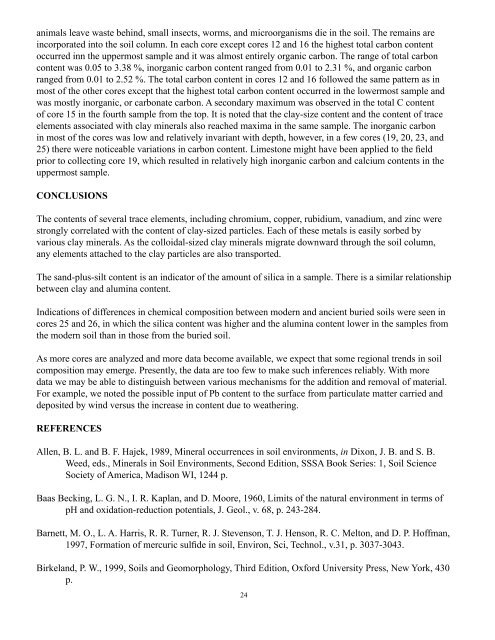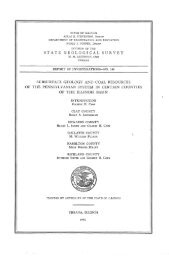Cores 11 through 26 by Gary B. Dr - University of Illinois at Urbana ...
Cores 11 through 26 by Gary B. Dr - University of Illinois at Urbana ...
Cores 11 through 26 by Gary B. Dr - University of Illinois at Urbana ...
Create successful ePaper yourself
Turn your PDF publications into a flip-book with our unique Google optimized e-Paper software.
animals leave waste behind, small insects, worms, and microorganisms die in the soil. The remains areincorpor<strong>at</strong>ed into the soil column. In each core except cores 12 and 16 the highest total carbon contentoccurred inn the uppermost sample and it was almost entirely organic carbon. The range <strong>of</strong> total carboncontent was 0.05 to 3.38 %, inorganic carbon content ranged from 0.01 to 2.31 %, and organic carbonranged from 0.01 to 2.52 %. The total carbon content in cores 12 and 16 followed the same p<strong>at</strong>tern as inmost <strong>of</strong> the other cores except th<strong>at</strong> the highest total carbon content occurred in the lowermost sample andwas mostly inorganic, or carbon<strong>at</strong>e carbon. A secondary maximum was observed in the total C content<strong>of</strong> core 15 in the fourth sample from the top. It is noted th<strong>at</strong> the clay-size content and the content <strong>of</strong> traceelements associ<strong>at</strong>ed with clay minerals also reached maxima in the same sample. The inorganic carbonin most <strong>of</strong> the cores was low and rel<strong>at</strong>ively invariant with depth, however, in a few cores (19, 20, 23, and25) there were noticeable vari<strong>at</strong>ions in carbon content. Limestone might have been applied to the fieldprior to collecting core 19, which resulted in rel<strong>at</strong>ively high inorganic carbon and calcium contents in theuppermost sample.CONCLUSIONSThe contents <strong>of</strong> several trace elements, including chromium, copper, rubidium, vanadium, and zinc werestrongly correl<strong>at</strong>ed with the content <strong>of</strong> clay-sized particles. Each <strong>of</strong> these metals is easily sorbed <strong>by</strong>various clay minerals. As the colloidal-sized clay minerals migr<strong>at</strong>e downward <strong>through</strong> the soil column,any elements <strong>at</strong>tached to the clay particles are also transported.The sand-plus-silt content is an indic<strong>at</strong>or <strong>of</strong> the amount <strong>of</strong> silica in a sample. There is a similar rel<strong>at</strong>ionshipbetween clay and alumina content.Indic<strong>at</strong>ions <strong>of</strong> differences in chemical composition between modern and ancient buried soils were seen incores 25 and <strong>26</strong>, in which the silica content was higher and the alumina content lower in the samples fromthe modern soil than in those from the buried soil.As more cores are analyzed and more d<strong>at</strong>a become available, we expect th<strong>at</strong> some regional trends in soilcomposition may emerge. Presently, the d<strong>at</strong>a are too few to make such inferences reliably. With mored<strong>at</strong>a we may be able to distinguish between various mechanisms for the addition and removal <strong>of</strong> m<strong>at</strong>erial.For example, we noted the possible input <strong>of</strong> Pb content to the surface from particul<strong>at</strong>e m<strong>at</strong>ter carried anddeposited <strong>by</strong> wind versus the increase in content due to we<strong>at</strong>hering.REFERENCESAllen, B. L. and B. F. Hajek, 1989, Mineral occurrences in soil environments, in Dixon, J. B. and S. B.Weed, eds., Minerals in Soil Environments, Second Edition, SSSA Book Series: 1, Soil ScienceSociety <strong>of</strong> America, Madison WI, 1244 p.Baas Becking, L. G. N., I. R. Kaplan, and D. Moore, 1960, Limits <strong>of</strong> the n<strong>at</strong>ural environment in terms <strong>of</strong>pH and oxid<strong>at</strong>ion-reduction potentials, J. Geol., v. 68, p. 243-284.Barnett, M. O., L. A. Harris, R. R. Turner, R. J. Stevenson, T. J. Henson, R. C. Melton, and D. P. H<strong>of</strong>fman,1997, Form<strong>at</strong>ion <strong>of</strong> mercuric sulfide in soil, Environ, Sci, Technol., v.31, p. 3037-3043.Birkeland, P. W., 1999, Soils and Geomorphology, Third Edition, Oxford <strong>University</strong> Press, New York, 430p.24
















